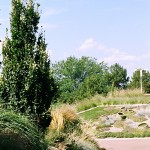We need only look around us to see the world out of balance. We can see the air we breathe, as it’s laden with chemicals. We can taste bleach and metal in the water we drink. Our rivers and lakes are overgrown with invasive species and toxic run off. Our food travels thousands of miles in petroleum burning vehicles only to arrive to our dinner tables laced with carcinogens and bacterial diseases. These problems are only a drop of water next to the ocean of trouble this planet is facing. Enough Is Enough! It’s time we clean up our act!
In a time of need like this the world has only one place to turn. Gardeners, I’m talking to you! It’s time we put our heads and hearts together to keep this planet from self-destructing.
Healthy Yards, Healthy Lives, 7 Steps for Growing Personal and Global Health in Your Own Back Yard!
Step 1: Capture Rain Water
Water is the source of life and that’s nowhere more apparent then the home garden. Not only
are we letting this most valuable food production resource run away from us, but water rushing from streets to sewers to rivers causes pollution and aquatic ecosystem destruction! We can’t afford to let our water go to waste any longer. Rain gardens are one very clever way to capture the rainwater that falls on your property. Planted with native species ready to survive and create a seasonal wetland, rain gardens not only hold and filter the rain they are also a source of habitat for birds, bees, butterflies, and more. So whether you just plop a rain barrel under your rain spout and water your tomatoes for free this summer, or you go all out and decide to install a rain garden, you’ll be doing yourself and the rest of the world a favor by placing a high value on that free falling food of life, rain water.
Step 2: Compost
We create mountains of garbage together daily! Composting is one great way to cut down on the amount of garbage your hauling out to the curb. Composting is easy, and beneficial. The old proverb about one persons garbage being another persons treasure surely applies here. Turning your kitchen and yard scraps into garden gold will bring abundance to your yard and cut down on your own personal contribution to Mt. Garbage!
Step 3: Create Habitat
Those of us lucky enough to have a yard to work in are charged with the responsibility of choosing what plants will grow in this space. Our decisions will either positively or negatively affect ourselves, and our fellow earthlings. Growing green grass lawns in your yard will give no edible benefit to you or anyone else. Instead of turf grass, try mixing your favorite edible plants with some pretty flowering annuals, native perennials, and fruit bearing trees and shrubs. The birds will thank you for the trees and shrubs, the butterflies will thank you for the flowers and native perennials, and you will thank yourself for being so smart as to grow your own food in a beauty filled environment teeming with life. Variety is truly the spice of life! The greater the diversity of plant species in your yard, the more beauty and health you will have at your fingertips.
Step 4: Source Responsibly
Think Globally, Act Locally! This is your opportunity to turn this smart slogan into a reality.
When we purchase goods produced close to or in the communities that we live, we benefit ourselves and the rest of the world. Think for a moment about the number of miles each food item you have has traveled to reach your kitchen shelves. When you purchase food and goods produced close to home, you boost your local economy, while at the same time reducing the amount of gasoline burned in order to stock your shelves. While your cutting back on fossil fuel consumption, you might as well cut out a few more petrochemicals used in food production and do your body good at the same time. Organically grown foods are much more nutritious and better tasting then their chemically grown cousins.
The closest to home that you can get is your own back yard. This step shows us that the more we give to our communities, the more benefits we share with the whole world.
Step 5: Harvest Responsibly
Now that you’ve got a garden full of goodies, you’ll want to make sure to not waste your bounty. Drying, canning, freezing, tincturing, and fermenting are some of my favorite ways to store goods. I
love this step because this is where I get to start giving out some of my homemade favorites. Think about what goods you can produce for yourself and your community. If you’ve got a cucumber vine that’s grown out of control, maybe you could be the pickle producer for your block that summer. I like to plant berries and tomatoes close to the street and alley so folks walking by can grab a bite to eat.
Step 6: Make It Beautiful
We can all learn from each others talents, and expressions, so we need to be willing to share our own. When we make garden spaces that we ourselves enjoy, it’s pretty likely that at least some of our friends and neighbors will delight in them as well. Creating an attractive home garden can be as simple as an annual flower patch, or as complex and integrated as a professional landscape design. Your imagination is your only limit
Step 7: Garden With Friends
We can’t fix this whole place by ourselves, we’re gonna need a little help. Join a garden club, hook up with local youth gardening programs, talk with your neighbors and family, or just invite your friends over for a homegrown meal. Connecting with others through gardening encourages a lifelong hobby that can grow community, family, health, and beauty.













































